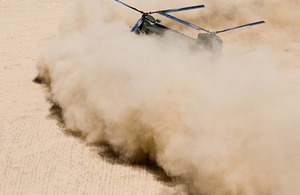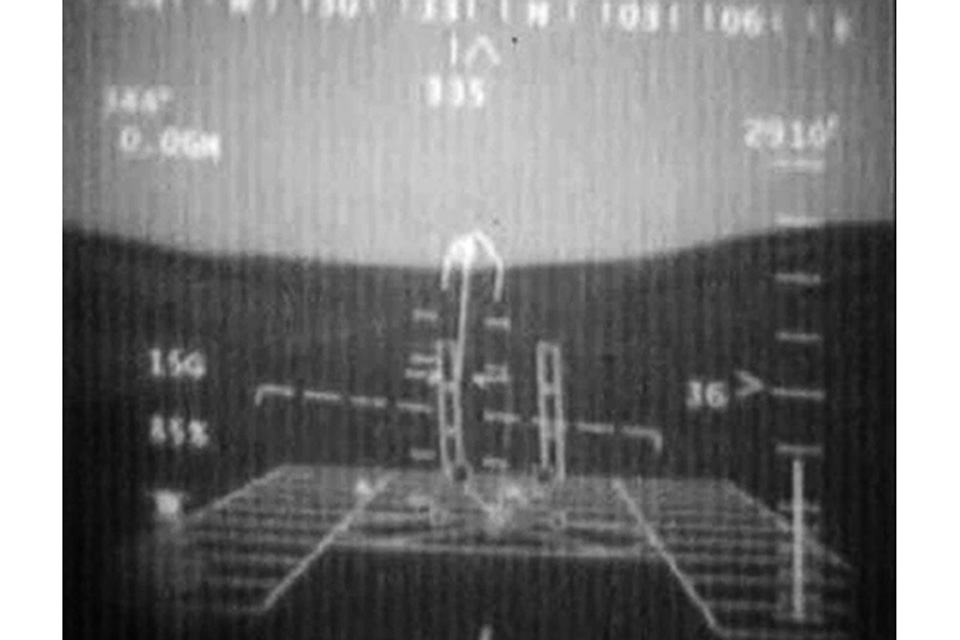3D technology helps helicopters land on sand
The Defence Science and Technology Laboratory (Dstl) and industry partners have showcased new technology that helps helicopter pilots land more safely in sandy and dusty environments such as those found in Afghanistan.

A Royal Air Force Chinook helicopter throws up a ring of sand and dust as it comes in to land in the North African desert in preparation for deployment to Afghanistan (stock image) [Picture: Senior Aircraftman Neil Chapman, Crown Copyright/MOD 2009]
Scientists from Dstl, part of the Ministry of Defence, have led the technical development of a pioneering approach to the problem of a low visibility landing (LVL) phenomenon known as ‘helicopter brownout’.
Helicopter brownout occurs when a pilot loses visual references due to dust and sand, or snow in colder environments, recirculating during take-off or landing.
Working with engineers at AgustaWestland, Dstl scientists analysed incident data to understand what happens and identify the cause. They also conducted a rapid technology assessment of as many available solutions as possible, including a simulator trial of one of the most promising technologies, three-dimensional (3D) conformal symbology. This uses a small helmet-mounted display to provide a virtual representation of the landing zone that stays fixed to the earth as the pilot approaches.
The symbology is carefully designed to augment the real-world picture but also to provide all relevant information to allow the pilot to easily judge the height, speed and drift. It then replaces the real-world cues when they are obscured by dust. The display can be also be fitted to night-vision goggles to ensure 24-hour capability.
The technology was demonstrated at an industry event at the Honourable Artillery Company in central London to support the Government’s National Science and Engineering Week.
The Dstl/industry team conducted successful flight trials demonstrating effective 3D conformal symbology in a Lynx helicopter from the Army Air Corps Development and Trials Squadron, based at Middle Wallop in Hampshire, in conjunction with the Rotary Wing Test and Evaluation Squadron based at Boscombe Down.
The team also conducted a further simulator trial using front line Merlin helicopter crews to refine the solution and conduct a large number of helicopter take-offs and landings to show that the system did indeed make these safer.
Follow-on development is nearing completion and subject to normal approval procedures the production system is expected to be deployed to front line helicopters in Afghanistan.

The head-up display of a helicopter fitted with new software to aid landing during brownout [Picture: Crown Copyright/MOD 2011]
Major John Peters of the Army Air Corps, lead test pilot for the LVL programme, said:
Brownout is a dangerous problem faced daily by UK helicopter crews in Afghanistan; when you come in to land the amount of dust blown up can completely obscure all visual references.
This makes landing more difficult and dangerous and increases the risk of damage. The development of the low visibility landing system will allow helicopter crews to land much more safely in these conditions, giving them references when they would otherwise be blind.
The ground-breaking work has earned the team a nomination for a Civil Service Award, designed to recognise the very best practice across the entire Civil Service. The low visibility landing team was on the shortlist for the innovation award.
Research continues into ways to allow pilots to operate more safely and effectively in low visibility conditions; civil applications could include the emergency and rescue services operating in adverse weather such as fog and mist.